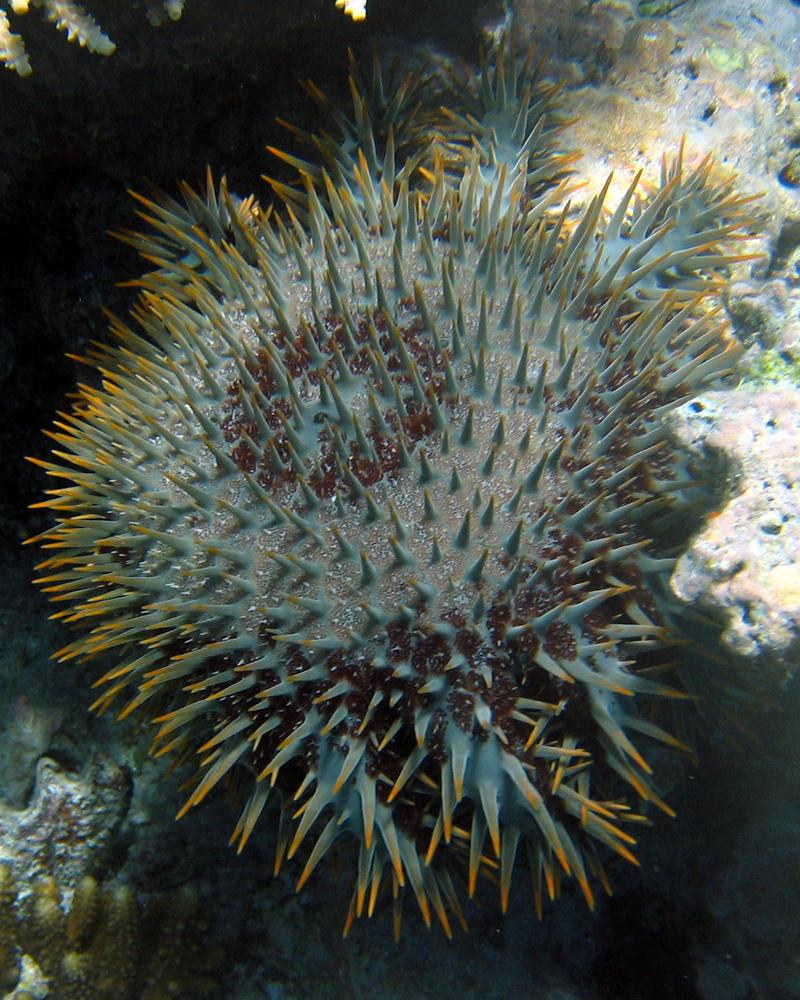Crown-of-thorns Starfish (Acanthaster planci) - Wiki Crown-of-thorns starfish
From Wikipedia, the free encyclopedia
Scientific classification
Kingdom: Animalia
Phylum: Echinodermata
Class: Asteroidea
Order: Valvatida
Family: Acanthasteridae
[Photo] Crown-of-thorns Starfish (Acanthaster planci). On a reef in Qamea Island, Fiji, 2005. Photographer: Matt Wright (http://en.wikipedia.org/wiki/User:MattWright). Date: October 12, 2005.
The crown-of-thorns starfish (Acanthaster planci) is a starfish with thorn-like spines sprouting all over its body for protection. These echinoderms grow to a diameter of up to 40 cm across and have 12 to 19 arms extending from their center.
If accidentally touched or stepped on by humans, the starfish's long spines (which release a neurotoxin) are capable of pricking and stinging, inflicting great pain that can last for hours, as well as nausea and vomiting. Frequently, the area around the puncture turns a dark blue (erythema) and begins to swell (edema). The swelling may persist for a number of days or weeks. If you are pricked by a crown of thorns, it is important to ensure any remnants of the spine are completely removed.
Crown-of-thorns starfish are found on coral reefs in the tropics ranging from the Red Sea, throughout the Indian and Pacific Oceans, and all the way to the Pacific coast of Panama.
The starfish is a coral reef predator (a corallivore) and preys on the coral polyps by climbing onto them, extruding its stomach over them, and releasing digestive enzymes to then absorb the liquified tissue. They feed alone at night, maintaining a constant distance between themselves and other crown-of-thorns starfish. During times of food shortage, these creatures can live on their energy reserves for over six months.
Populations of the crown-of-thorns starfish have increased since the 1970s, and this species is at least partly responsible for much loss of coral reefs, particularly on the Great Barrier Reef in Australia after being discovered in 1963. They are voracious predators that can wipe out large areas of coral; an individual can consume up to 6 square meters of living reef per year.
The crown of thorns can grow from the size of a grain of sand to the size of a dinner plate. An exceptionally large crown of thorns can grow to be the size of a car tire. Divers kill these predators by injecting the starfish's own stomach acid into each of their many legs. If even one leg is missed the sea star can live on. Before overpopulation, crown of thorns kept the fast growing coral from overpowering the slower growing coral. It then proceeds to destroy the coral. It has become a threat to the Great Barrier Reef
Outbreaks of huge numbers of these starfish are believed to be caused by agricultural runoff which causes algal blooms. The connection lies probably in the increased amount of algae supplying coral polyps (which eat the eggs of Acanthaster) with large amounts of food, thus reducing predation on the starfish's eggs. Since the eggs drift considerable distances in the plankton, the runoff would have to occur on the settling, not the spawning, grounds. This also explains the phenomenon of massive outbreaks seemingly appearing out of nowhere, with no previous indication of an increasing population at the affected site.
Few animals in the sea are willing to attack the spiny and toxic crown-of-thorns starfish, but surprisingly, some sea creatures prey on them. Notable predators of Ancanthaster planci include the Giant Triton (Charonia tritonis), a species of shrimp, a species of worm, and various reef fish (especially the Humphead wrasse) which feed on larvae or small adults. It is quite likely that the decline of these predators (through overharvesting, pollution, etc.) has been a factor that led to the rise in the population of the starfish, making outbreaks more likely to occur.
Acanthaster planci, the crown-of-thorns starfish, due to its notorious damage to reefs, has been described as one of the most influential species in the diverse biotic communities that make up tropical coral reefs (Birkeland, 1985). It is in fact a most important member of coral reef biodiversity, as it is the main force driving ecological succession where it occurs. Outbreaks, especially when occurring with increased frequency or in combination with other factors such as coral bleaching or Black band disease, may, however, cause permanent damage.
http://en.wikipedia.org/wiki/Crown-of-thorns_starfish
| The text in this page is based on the copyrighted Wikipedia article shown in above URL. It is used under the GNU Free Documentation License. You may redistribute it, verbatim or modified, providing that you comply with the terms of the GFDL. |
